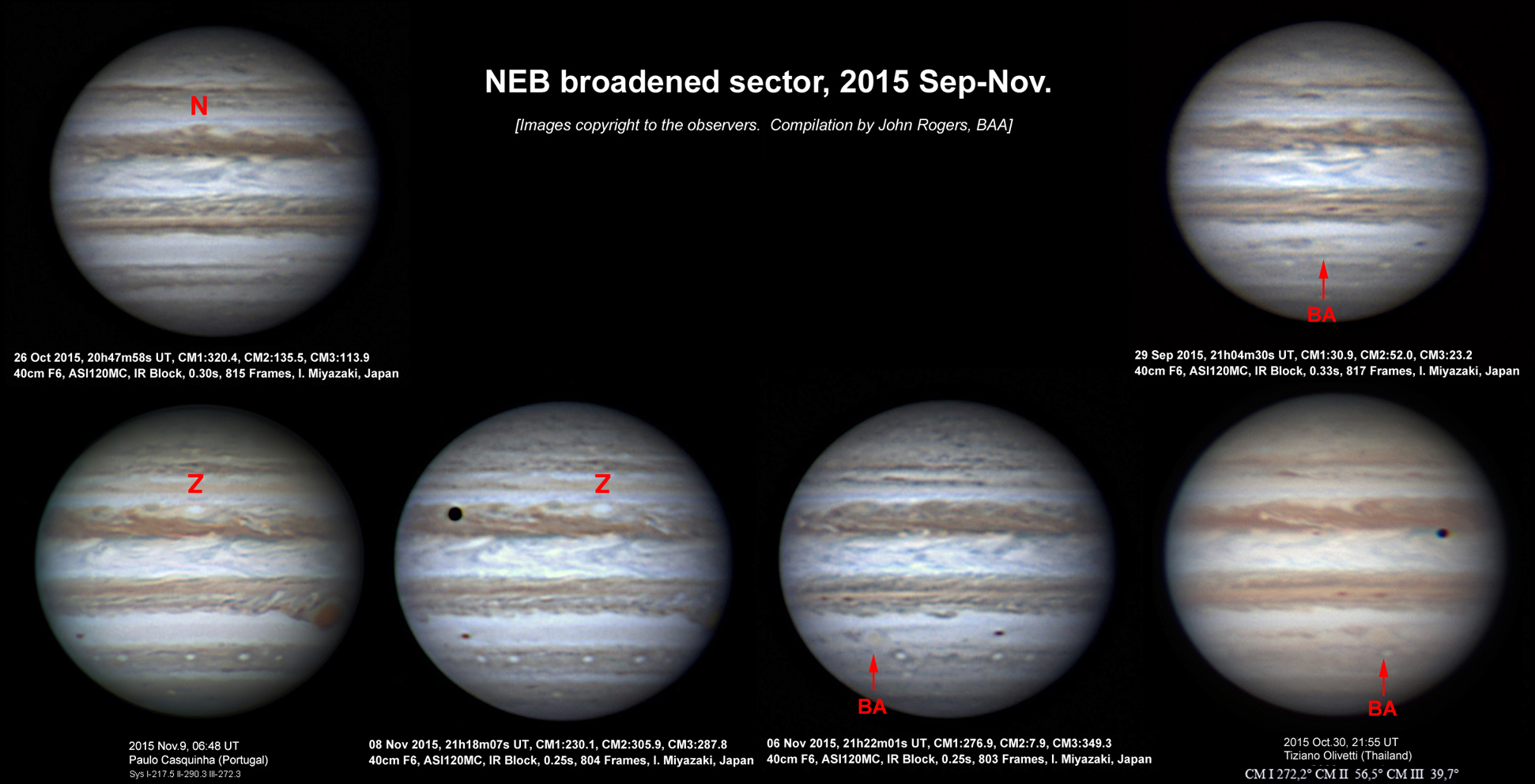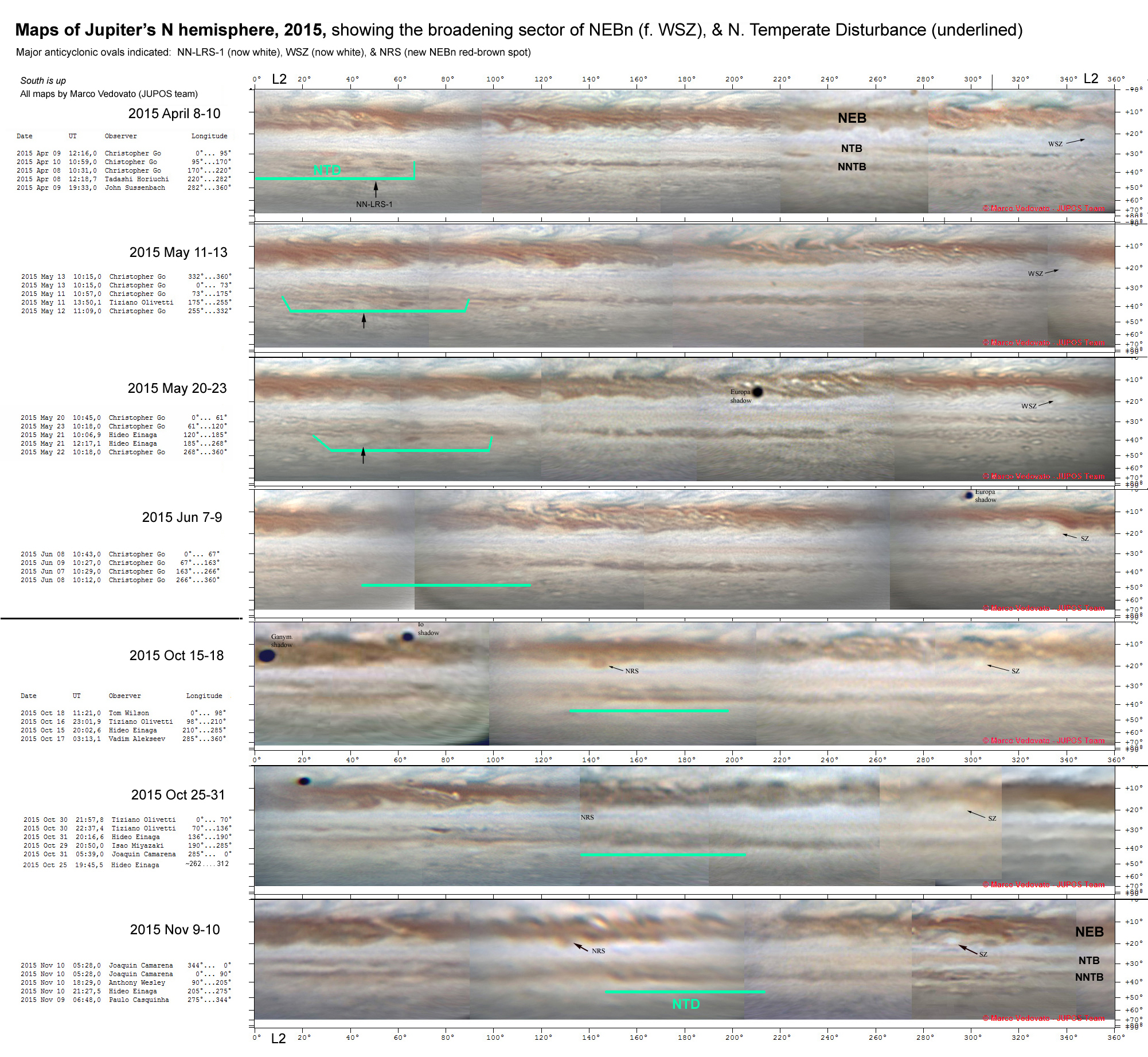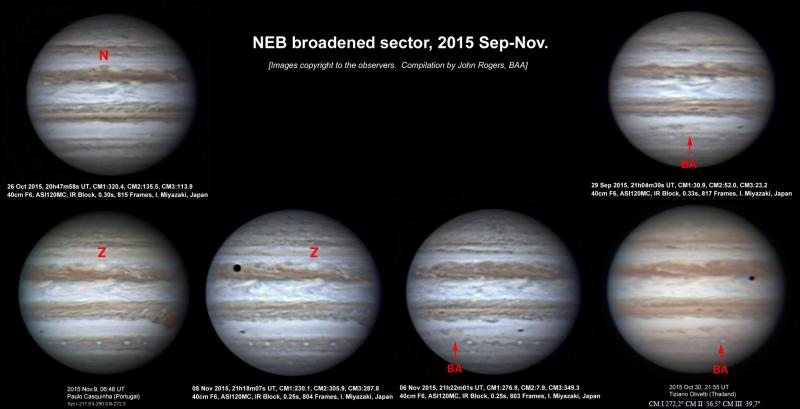2015/16, Report no.1: Full-size figures




 Jupiter in 2015/16: Report no.1
Jupiter in 2015/16: Report no.1
New NEB expansion event
A NEB expansion event appears to be underway, i.e., broadening of the NEB northwards into the N. Tropical Zone. Such an event had been predicted to occur in 2015 [ref.1], and during the first half of the year, there were signs of increased emission of dark material northwards from the NEB, which Christopher Go and Christophe Pellier both suggested might be the early stages of the expansion event, but it did not develop convincingly. Now, according to the latest maps produced by Marco Vedovato, there is a distinct broadened sector f. White Spot Z (WSZ), from L2 ~ 315-50 (L3 ~ 300-35). The recent maps suggest that it is beginning to spread around White Spot Z. Another notable feature is the dark spot at L2 = 291 (L3 = 277), named ‘Northern Red Spot’ (NRS) by Vedovato; such dark reddish-brown anticyclonic spots are often produced before or during NEB expansion events. (I have sometimes called them ‘little brown spots’, but this one is obviously redder than the adjacent NEB.)
This sector of NEBn f. WSZ had shown some transient broadening in 2014 Oct-Nov. (when a new slowly prograding rift developed p. WSZ), and it remained disturbed thereafter, sometimes with undulations, especially after the major rift passed it in late March. This same sector has now broadened fully during solar conjunction.
NEB expansion events occurred in 1987/88, 1993, 1996, 2000, 2004, and 2009; then there was an extreme version in 2012, the NEB Revival. For a summary and discussion of them, see [ref.2]. A further event was predicted to occur in 2015, not only because of the 3-5-year periodicity, but also because two mid-NEB rifts appeared in late 2014 with DL2 ~ -2 deg/day. We recently discovered that rifts like these, which are more slow-moving and more northerly than most mid-NEB rifts, tend to initiate NEB expansion events [ref.1, & paper in preparation].
In view of its very slow build-up, the present event looks similar to that in 2000 [ref.3], which likewise got under way during solar conjunction. An especially interesting phenomenon in 2000 was a large-scale wave pattern seen in methane-band images as the expansion became complete; the methane-dark waves likely arose from the visible circulations along the NEBn, and coincided with thermal waves recorded by Cassini [refs.4 & 5]. However, this phenomenon has not been observed again at subsequent expansion events (except for a short sector in 2009). One possible explanation is that in 2000, an array of barges still existed from the previous cycle and induced the prominent waves, whereas usually (as this year) all the previous barges have disappeared.
If this is really the start of a NEB expansion event, it is likely to spread around the planet over the next few months, and observations will be of great interest. Will it spread steadily westwards, or will broadening develop irregularly at other longitudes, possibly with one or more secondary sources of expansion? Will there be interactions with mid-NEB rifts, and effects on the NEBs dark formations? Methane-band images, especially when the expansion nears completion, could show whether the wave phenomenon of 2000 is repeated. (More selective filters will probably be more sensitive for this purpose.) About a year from now, when the belt is fully expanded, a new array of barges and AWOs should start to emerge.
References:
[1] Rogers JH, ‘Jupiter in 2014/15: Report no.5: A 3-year weather forecast for Jupiter.’
http://www.britastro.org/jupiter/2014_15reports.htm [go to no.5]
[2] Rogers JH, ‘Jupiter in 2009:, Report no.7: Interim Report, with new insights into the
NTZ disturbance, NEB expansion, and SEB fading.’
http://www.britastro.org/jupiter/2009report07.htm
[3] Rogers J, Mettig H-J, Peach D, & Foulkes M, JBAA 114 (no.4), 193-214 (2004).
Jupiter in 2000/2001: Part I: Visible wavelengths: Jupiter during the Cassini encounter.
[4] Rogers JH, Akutsu T, & Orton GS, JBAA 114 (no.6), 313-330 (2004).
Jupiter in 2000/2001: Part II: Infrared and ultraviolet wavelengths:
A review of multispectral imaging of the jovian atmosphere.
[Refs. 3 & 4 are available as PDFs:] http://www.britastro.org/jupiter/publications_index.htm
[5] Li L, et al. (2006) Icarus 185, 416-429. ‘Waves in Jupiter’s atmosphere observed by the Cassini ISS and CIRS instruments.’
Illustrations:
Here are reduced-size versions of figures with north up: An annotated map of the planet, and a selection of the best recent images. Larger versions, and alternative versions with soth up, will be posted in the following links. In addition to the broadened sector of NEB, a darkened sector of N. Temperate Zone called a N. Temperate Disturbance is also marked.


FigN_Map_L3_2015nov09-10.jpgFig-N_NEB-expansion-images_2015sep-oct.jpgFigS_Map_L2_2015nov09-10.jpgFig-S_NEB-expansion-images_2015sep-oct.jpgFigS_Maps_L2_2015Apr-Nov_N-Hemis.jpg
| The British Astronomical Association supports amateur astronomers around the UK and the rest of the world. Find out more about the BAA or join us. |
